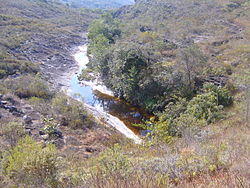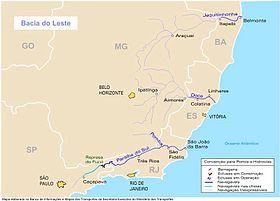| Jequitinhonha | |
|---|---|
 Source of the river in Serro | |
 Southeastern Brazil with major rivers highlighted; Jequitinhonha is the northernmost | |
| Location | |
| Country | Brazil |
| Physical characteristics | |
| Source | Espinhaço Mountains |
| • location | Diamantina, Minas Gerais |
| • elevation | 1,200 m (3,900 ft) |
| Mouth | Atlantic Ocean |
• location | Belmonte, Bahia |
• coordinates | 15°51′00″S 38°51′27″W / 15.85000°S 38.85750°W |
• elevation | Sea level |
| Length | 1,090 km (680 mi) |
| Basin size | 78,451 km2 (30,290 sq mi) |
| Basin features | |
| Waterfalls | Cachoeira do Salto Grande |
The Jequitinhonha River (Portuguese pronunciation: [ʒekitʃiˈɲõɲɐ]) flows mainly through the Brazilian state of Minas Gerais. Its source lies near Diamantina in the Espinhaço Mountains at an elevation of 1,200 metres (3,900 ft), after which it flows northward and then east-northeastward across the uplands. At Salto da Divisa, it is interrupted by the Cachoeira (falls) do Salto Grande, 43 metres (141 ft) high. The river descends to the coastal plain at the city of Jequitinhonha, beyond which it is also called Rio Grande do Belmonte, and empties into the Atlantic Ocean at Belmonte in Bahia state after a course of approximately 1,090 kilometres (680 mi). The main tributaries are the Araçuaí River, Piauí, São Miguel, Itacambiruçu, Salinas, São Pedro, and São Francisco.
The valley of the Jequitinhonha is one of the poorest regions of Brazil and is still prone to endemic yellow fever. It covers 78,451 square kilometres (30,290 sq mi), twice the size of Switzerland, and has an approximate population of one million people, distributed in about 80 municipalities. The most populous of these is Almenara (36,254 in 2004) located on the middle Jequitinhonha.
The valley is known for its variety of gemstones, colonial-era towns, unique handicrafts and starkly beautiful landscapes immortalized by the Brazilian author João Guimarães Rosa.
Most of the soil is arid and is periodically affected by drought or floods. The economically active population numbers over 400,000, of which 180,000 are in the rural areas practicing rudimentary agriculture and cattle raising. Industry employs 50,000 people and is the most important economic source for the municipalities.
In the past the region was covered by forests and occupied by indigenous people. What contributed to the deforestation and subsequent degradation of the region was the predatory activity of mining and extraction of diamonds.
Today there are attempts to develop the work of local artisans, especially in ceramics. While living in total isolation, they have developed ceramic craftwork that is mainly performed by the women, who belong to associations. They make utilitarian pieces that are ranked as the most creative works of Brazilian popular art. The famous "dolls" from that region are in fact pitchers for holding fresh water, thus losing this function and becoming decorative objects.
The electrical company of Minas Gerais (CEMIG) constructed a hydroelectric plant on the river between Berilo and Grão Mogol. The Usina Presidente Juscelino Kubitscheck, the hydroelectric plant powered by Irapé Dam, has an installed capacity of 360 MW and regulates the waters of the river which periodically flood. CEMIG began the work in 2002 and in April 2003 diverted the river to two tunnels with a length of more than 1.2 km (three-quarters of a mile). The dam and power station were completed in 2006.
See also
- List of rivers of Bahia
External links
- Photos of the Jequitinhonha
- Map of Doce and Jequitinhonha Rivers Copied from Documents Found in the House of Representatives from the 19th century